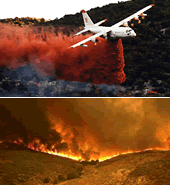FIGHTING WILDFIRES

Publications and Resources
NIOSH Publications
Aviation-Related Wildland Firefighter Fatalities — United States, 2000–2013
During 2000–2013, 78 wildland firefighters were fatally injured while participating in wildland fire duties involving aircraft. Although the number of wildland firefighter deaths due to aviation-related incidents have decreased in recent years, the study showed working with and around aircraft is still one of the highest risk activities for firefighters.
Arterial stiffness, oxidative stress, and smoke exposure in wildland firefighters
An assessment of the association between exposure, oxidative stress, symptoms, and cardiorespiratory function in wildland firefighters. Biomarkers of oxidative stress may serve as indicators of arterial stiffness in wildland firefighters.
Wildland Fire Fighting: Hot Tips to Stay Safe and Healthy
NIOSH Publication No. 2013-158 (September 2013)
Every year, hundreds of thousands of acres of land burn across the United States and wildland fire fighters (WFFs) are asked to protect our lives, our homes and our forests. But fires are unpredictable and dangerous. In fact, over 200 on-duty WFF fatalities occurred between 2001 and 2012.
En Español
Preventing Heat-related Illness or Death of Outdoor Workers
NIOSH Publication No. 2013-143 (May 2013)
The National Institute for Occupational Safety and Health (NIOSH) recommends that employers have a plan in place to prevent heat-related illness. The plan should include hydration (drinking plenty of water), acclimatization (getting used to weather conditions), and schedules that alternate work with rest. Employers should also train workers about the hazards of working in hot environments.
Promoting Hearing Health among Fire Fighters
NIOSH Publication No. 2013-142 (May 2013)
Provides recommendations to promote better hearing health through the use of quieter equipment, better work practices, hearing protection devices, and implementation of effective hearing loss prevention programs.
Preventing Death and Injuries of Fire Fighters Operating Modified Excess/Surplus Vehicles
NIOSH Publication No. 2011-125 (December 2010)
Fire fighters may be at risk for crash-related injuries while operating excess and other surplus vehicles that have been modified for fire service use. The National Institute for Occupational Safety and Health (NIOSH) has summarized recommendations to prevent injuries and deaths while operating these vehicles.
Preventing Fire Fighter Fatalities Due to Heart Attacks and Other Sudden Cardiovascular Events
NIOSH Publication No. 2007-133 (June 2007)
NIOSH recommends that fire departments and fire fighters follow established medical screening guidelines, adopt risk reduction measures during fire fighting operations, and develop and participate in comprehensive wellness/fitness programs.
En Español
Hazard ID: Fire Fighters Exposed to Electrical Hazards During Wildland Fire Operations
NIOSH Publication No. 2002-112 (January 2002)
NIOSH investigated two separate incidents in 1999 in which fire fighters died or were seriously injured from exposures to electricity while fighting wildland fires.
En Español
Hazard ID: Traffic Hazards to Fire Fighters While Working Along Roadways
NIOSH Publication No. 2001-143 (June 2001)
The number of fire fighters struck and killed by motor vehicles has dramatically increased within recent years. This document details case studies and provides recommendations for prevention.
En Español
Other Resources
NIOSH Wildland Fire Fighter Safety and Health Blog
Wildland fire fighting can be a dangerous occupation. The men and women fighting theses fires face many hazards. Read more on the NIOSH Science Blog
Rhabdomyolysis: What Wildland Fire Fighters Need To Know
Wildland firefighters are at increased risk for rhabdomyolysis. This document defines rhabdomyolysis, identifies the sign and symptoms and what to do if a fire fighter has symptoms.
Worker Safety During Fire Cleanup
CDC Fact Sheet details types of hazards that workers may face during fire clean up efforts, including electrical hazards, carbon monoxide poisoning, musculoskeletal hazards, heat stress, hazardous materials, & confined spaces.
- Page last reviewed: December 4, 2014
- Page last updated: August 5, 2015
- Content source:
- National Institute for Occupational Safety and Health Western States Office


 ShareCompartir
ShareCompartir